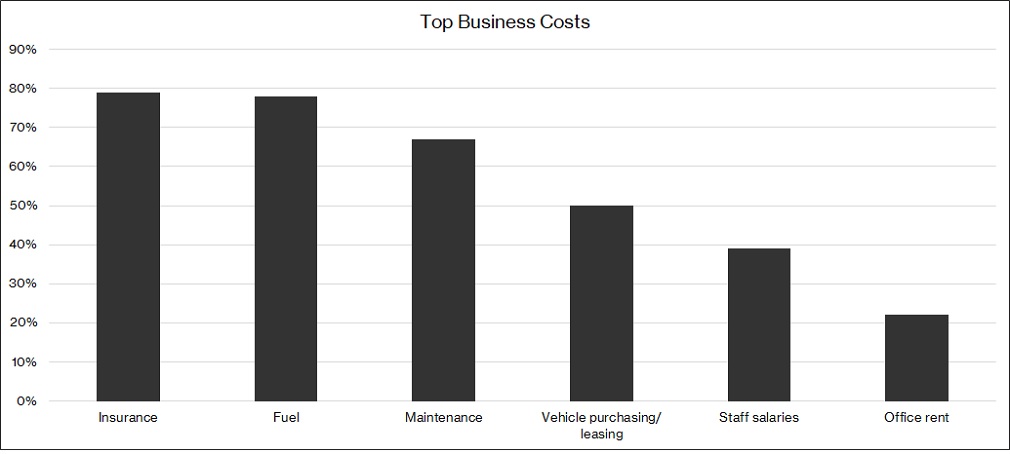How smart video fuels smart business
Learn how innovations in video powered by AI and machine learning are helping to reshape safety and efficiency for businesses.
Read more
Small fleets are generally defined as fleets with fewer than 100 vehicles, with mid-size fleets ranging from 100-300 vehicles.1 There are a number of benefits related to operating a smaller fleet in the modern industry landscape. Small companies have fewer vehicles and assets to keep track of and hence lower overhead. The agility to respond to customers quickly is both the need and characteristic of a small fleet business.
Another benefit of smaller fleets is the opportunity for faster growth: “Growth in the number of very small fleets, those with fewer than six trucks, has far outpaced growth in the number of larger carriers in recent years.”2 As these businesses continue to grow, small fleet managers deal with the same issues as mid- and large-sized fleets, in addition to some unique challenges. Just like their larger counterparts, small fleets are looking to technology to address these challenges and make an impact in their business.
In a recent survey by Bibby Financial Services, 68% of smaller carriers (1-100 trucks) cited increasing costs as their top challenge.3 While insurance was top expenditure for most businesses, fuel and vehicle maintenance were the second and third biggest costs.

Those surveyed also noted some of the technologies that will have the biggest effect on transportation over the next three years. 47% of small carriers cited ELDs, followed by route optimization (28%) and predictive maintenance (28%).3
Small fleet businesses are looking to battle the growing competition by investing in technology at the right time. Many such businesses have already firmed up their technology investment plans for the next two years.4 33% of the businesses wanted to invest in predictive maintenance, 30% in route optimization, and 29% in fleet management. This is where a good Telematics solution can change the way you do business and keep up with the complex business needs.
From fuel savings to streamlined maintenance, the following are some of the ways a telematics solution can help streamline fleet management, improve operating efficiency, and increase your bottom line.
Knowing how to accurately track fuel costs can be a big challenge for small fleets, even if they have been in business for a long time. Constant changes in oil prices, duties and other taxes can further complicate the situation. However, with the right data and best practices, small fleets can win the fuel battle.
Monitor. Measure. Educate. Repeat. These steps could be your key to affect a positive change in fuel economy for your business. Monitoring fuel usage, measuring the data, educating your drivers, and doing it periodically. Start to change the way you think about fuel economy by:
With data collected from a GPS tracking solution, you can tackle the most important first step, that is, monitoring your fuel consumption frequently and accurately. This allows you to understand a variety of factors that impact your fleet’s fuel costs, enabling you to implement an ongoing fuel management program to help increase fuel efficiency.
For small fleets, taking even one truck out of rotation can lead to a scheduling disaster that results in loss of productivity, which in turn affects your customers and your bottom line. When it comes to managing the health of all fleet vehicles, preventive fleet maintenance is the most important step.
Telematics as a fleet management solution can help streamline maintenance processes for routine updates, such as tire rotations and oil changes, as well as bigger fixes. This helps to decrease expenses and keep all vehicles in safe operating condition. Managers of small fleets have the additional burden of keeping track of maintenance schedules. This process can take away this added pressure and help them focus on other productive activities.
From generating vehicle maintenance alerts, to improving preventative maintenance program accuracy to controlling costs, here are some of the maintenance benefits of fleet tracking technology:
Safety is a top concern for small fleet managers and drivers—your employees are important to you, and you want to keep them as safe as possible. Telematics helps improve driver safety by monitoring the location and speed of every fleet vehicle. The technology also provides near real-time alerts when speeding incidents occur or other risky driving behaviors like hard braking and fast acceleration. Managers can set alerts based on unsafe driving conditions such as rain or snow or set a lower-limit speeding alert when vehicle wipers are active.
Telematics also helps support drivers in emergency situations by leveraging live location tracking to enable a faster, more efficient emergency response. In addition, when used in conjunction with integrated video, managers can view video clips of harsh driving events within minutes of an incident. These can then be used to coach drivers in improving safety, while at the same time rewarding those drivers who are already performing well.
For small fleets, the more flexibly a vehicle can be dispatched and the more accurately all vehicles and assets can be routed, the greater the ability to rein in expenses. Telematics allows small fleet managers and operators to quickly locate the nearest worker with the right skills and vehicle for a job, reducing per-mile costs. It also alerts managers and drivers to any traffic congestion or inclement weather, giving alternate routes to avoid any potential delays.
Telematics data also lets you identify which equipment and vehicles could be getting you a better ROI, and which should be sold or relocated. Finally, telematics helps managers improve responsiveness during emergencies and unexpected events, enabling you to instantly change vehicle routes and schedules at a moment’s notice.
Fleet management technology is here to stay. Here are signs signs that your business is ready for this telematics revolution. Download this free eBook now.
1 - https://www.automotive-fleet.com/148112/mid-size-fleets-measure-up
2 - https://www.overdriveonline.com/and-the-data-says-owner-operator-market-the-hottest-fleet-segment/
3&4 - https://www.bibbyusa.com/about-us/news-and-insights/reports/bfs-us-trucking-trends-report
Tags: Cost control, Field management, Productivity & Efficiency, Revenue & ROI, Safety, Vehicle Maintenance




Find out how our platform gives you the visibility you need to get more done.
Learn how innovations in video powered by AI and machine learning are helping to reshape safety and efficiency for businesses.
Read moreAre you ready for vehicle tracking? Go through our checklist to learn the signs you’re ready to add fleet tracking to...
Read moreLearn how AI, machine learning, and predictive analytics is improving fleet accurating and cutting costs.
Read moreLearn how telematics can lead to operational improvements.
Read more